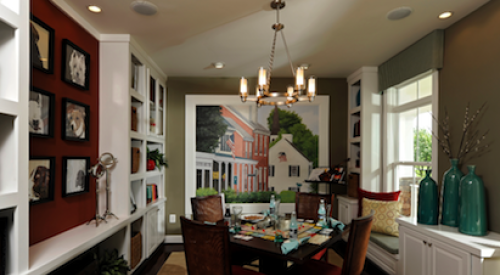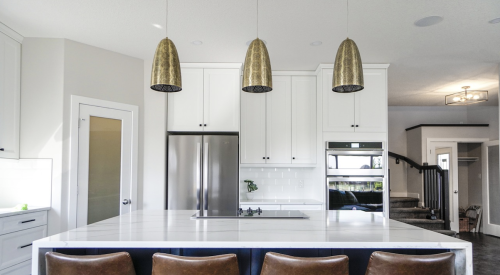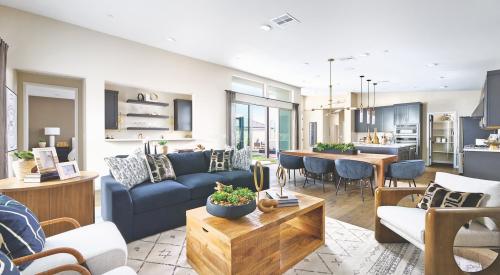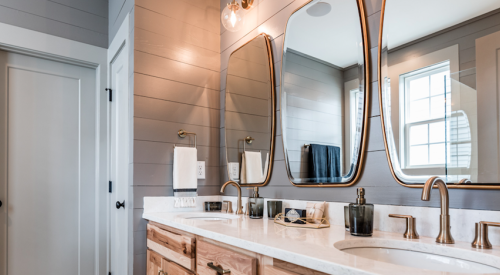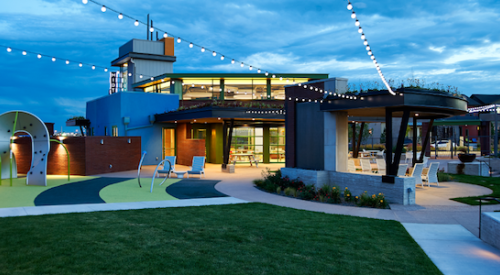| This California kitchen exemplifies the outdoor connection -- the herb garden brings the outdoors in.
|
Once upon a time (and not all that long ago), there was no such thing as a properly merchandised model home. This made any model pretty exciting -- to the industry and to our buyers. The requirements were basic: furnished, color-coordinated homes looked "done," and put the builder ahead of the competition.
As consumers and interior design evolved, so did model homes, with merchandising supporting a well-defined theme determined from researched demographic profiles. Now our models show it all -- svelte master suites, memorable kids’ rooms, a tidy home office and a gourmet kitchen.
They look great, but are they complete? Some are, yes, but the majority offer formulaic answers to the easy questions:
- How old is the buyer?
- Income?
- Kids -- how old and how many?
- What is the price point?
- How many bedrooms?
Many models that look great address these questions nicely. Models that are great also answer another question: In this place and in this time, what should we be asking about our buyers? How about these questions for starters:
- What kind of life do the people who visit our kitchens and bedrooms want?
- What are they looking for when they come to our new homes that they do not have in their existing home?
- What can design and architecture do to provide for these things?
Selling Emotion
The right answers to these questions translate deeply held emotions into thoughtful plans and interiors. They generate truly effective models, which may not look much different from the almost greats, but really are. Great models let prospects share in the life they see in every room, a life they want.Thoughtful touches like niches for art and lots of natural light show buyers that you understand what they want. Satisfying buyers’ hearts means creating models that express understanding of people’s desires and empathy with their sensibilities -- show them the potential for luxuriating in wonderful new "life spaces". Go beyond the statistics of your market research, and take a strong personal approach to understanding those sensibilities.
Who’s Out There? Good research starting points include your historic customer base, plus ages, incomes and kids. Dig deep and take notes. For example, empty nesters and retirees from California are heading for small and medium-sized towns in other states. Special opportunities should abound for builders who offer the California flavor in these locations. A sun-filled kitchen with a pop-out window to hold a small herb garden the homeowner can use to cut off fresh ingredients for cooking will be a boon to anyone dealing with winter. To a buyer moving from California, it says you understand the indoor/outdoor connection that is a passion in the Golden State.
In urban infill markets, first-time buyers may be older than the usual young couple. Demonstrate respect for their maturity with models that show a more educated sense of design. Try a wine rack in the kitchen island or a focal niche in the entry hall or entertainment room for a treasured piece of art. In the kitchen offer optional counter surfaces for added flair, such as granite tile -- very stylish and far less costly than it used to be.
Embrace the future and let it embrace your models. High-tech homes let buyers see themselves plugged in and capable of expansion. Go at least one better than the now humdrum computer station in the den/home office. Show the computer as an in-home friend, show more than one in the model, and make one station live and interactive.
The kitchen computer could display a list of chores, notes from household members or one of the Internet’s food shopping services. The state of the art refrigerator now includes a built-in voice message center. In the den of a senior’s home, the computer could be engaged in the family history, with genealogy sites, and photo scans preserving dearly loved and very personal images. A laptop can be in a bedroom.
Theme-complementary technology should be built in to the home and touted to the buyers: high-speed wiring, home networking capabilities and at least two phone lines. Show flat screen televisions in the higher end, and optional state of the art sound and theater systems. If your buyers are really hip, "merchandise" one room with projection images.
Additionally, showing ways to cope with environmental stresses demonstrates positive respect for reality. Buyers in your market may really appreciate optional faucet filtration systems and recycling centers. Consider merchandising Energy Star features. First-time buyers certainly appreciate lower utility bills while high-end customers love knowing their pricey carpets and wall coverings won’t fade so quickly with Low-E windows in their new home. These are all great marketing tools.Imagine the people who might live in your homes and what’s important to them in their everyday lives. The TV, for instance, is everywhere -- in the living room, the kitchen and the bedroom. Make room for it. Tap into the information age during the planning process -- your buyers do. In every market there is a cascade of images from TV, the Internet, magazines and newspaper advertising. Add all types of cross-cultural input and understand that buyers are tuned in to countless new ways to translate their dream. Decorating magazines, Martha Stewart and lookalikes, catalogues and home stores galore fuel an endless exploration of home and garden, with furnishings, entertainment ideas, linens, accessories, personal care products, fashion and cookery.
This is no accident -- enjoying life at home is what we’re all about. What has changed is your buyers’ exposure to new possibilities. So bring some zest into your models, with the new, cool, fun things you and your buyers see everywhere. The point is to reach out on today’s wavelengths.
Human Design
Have more fun -- design for humans, not for "consumers". Put liveliness in and take stereotyping and stiffness out. Create better kids’ rooms -- something I’ve mentioned before. In lieu of the obligatory ballerina or fairy princess in the girl’s room, why not try decor for the committed athlete? Consider genderless presentations by adopting a theme that speaks to the serious musician, scholar or the budding techie who loves computers and sci-fi? These rooms offer fresh themes and make points with the right audience.Have fun with adults’ need to veg out too. Why not include an automated drape for the master bedroom and a proper place for the TV? We love our beds! We love our TV! TV and late nights made Johnny Carson’s career, so let’s wire the adult hideaway for cable. Include a good sized niche across from the bedwall for a television and create a place that invites enjoyment of those precious hours of respite and privacy.
Discover the subtleties of your market and make sure your models reflect them. When interiors capture the human spirit, people notice, remember and begin to consider exactly what you hope: the purchase of one of your new homes.
